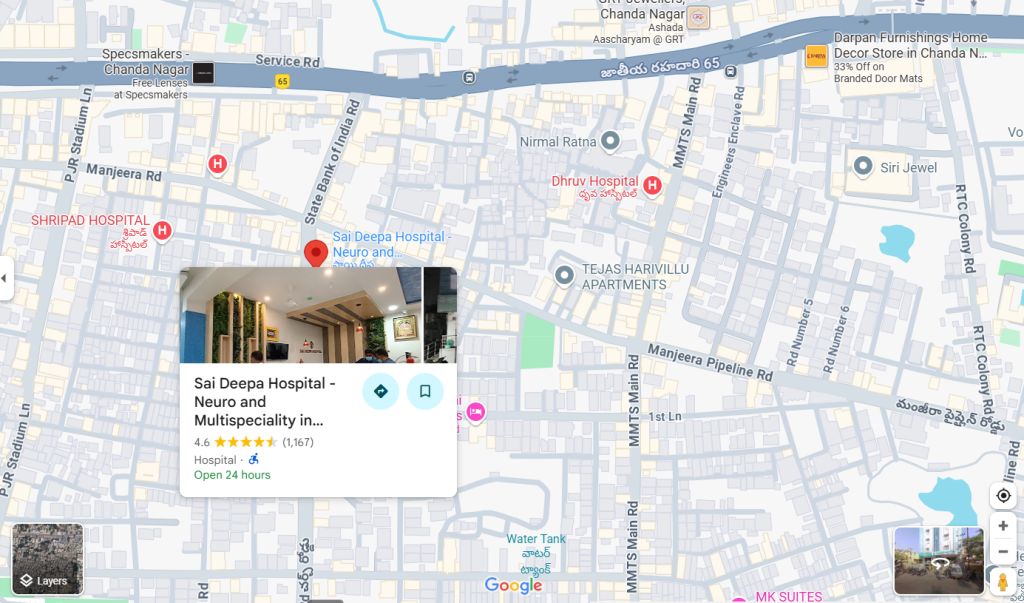Best Diabetic Foot Treatment in Hyderabad
- Home
- Best Diabetic Foot Treatment in Hyderabad
Best Diabetic Foot Treatment in Hyderabad
Diabetes is one of the fastest-growing health concerns across the world. While it affects several organs and body systems, one of the most commonly overlooked complications is Diabetic Foot. For many patients, this condition can start with mild symptoms like numbness or dryness, but if left untreated, it may lead to severe infections, ulcers, and in advanced cases, even amputations.
The good news is that with timely care, lifestyle changes, and proper medical treatment, patients can manage Diabetic Foot problems effectively.
Book Free Appointment
1L+
Happy Customers
25+
Qualified Doctors
50
Rooms
5000+
Successful Surgeries
Free
Consultation
24/7 Ambulance
Facility
Insurance
Claim Support
What is a Diabetic Foot?
A Diabetic Foot refers to complications in the feet caused by long-standing diabetes. High blood sugar levels damage nerves and blood vessels over time. This damage reduces sensation in the feet and slows down blood circulation, making the feet more prone to wounds, infections, ulcers, and deformities.
Since the nerves are affected, many patients may not feel pain even when there is a cut, blister, or sore. Without timely treatment, these small injuries can worsen, leading to serious complications.

Dr. Sasidhara Roa A
MBBS, MS
5000+ Successful Surgeries
11+ Years of experience
Dr. Sasidhara Rao A. is an experienced General and Laparoscopic Surgeon at Sree Sai Deepa Hospitals, Chandanagar, with over 11 years of expertise and 5000+ successful surgeries. He specializes in laparoscopic, laser, and microscopic surgeries, treating conditions like piles, fissures, varicose veins, and gallbladder issues.
Doctor’s Fellowships:
Fellowship - International Society of Coloproctology
Fellowship in Intimate Health
Fellowship in Diagnostic Endoscopy
Why Does Diabetic Foot Occur?
The main reason for developing Diabetic Foot problems is uncontrolled or poorly managed diabetes. Two major changes occur in the body due to high blood sugar:
Nerve Damage (Diabetic Neuropathy):
The nerves in the feet lose their ability to sense temperature, pain, or pressure.
This means injuries often go unnoticed until they become severe.
Poor Blood Circulation (Peripheral Vascular Disease):
Diabetes causes narrowing of blood vessels.
Reduced blood flow delays wound healing, increasing the risk of infections.
These two factors together create a dangerous situation for the feet, where even small injuries can develop into life-threatening complications.
What are the Symptoms of Diabetic Foot?
Recognizing the early symptoms of Diabetic Foot can save patients from major complications. Common warning signs include:
Numbness or tingling in the feet
Burning or sharp pain (especially at night)
Dry or cracked skin
Swelling in the feet or ankles
Foot deformities like hammertoes or bunions
Changes in skin color or temperature of the feet
Slow-healing cuts, blisters, or sores
Presence of pus, foul smell, or discharge from wounds
If you notice these symptoms, consult a doctor immediately to avoid worsening of the condition.
How Does Diabetic Foot Progress?
The progression of Diabetic Foot complications depends on how well diabetes is managed. In the early stages, symptoms are mild, such as dryness, numbness, or minor skin changes. As nerve damage and circulation problems increase, wounds heal slowly, leading to infections and ulcers.
In advanced cases, untreated ulcers can damage tissues and bones. This may require surgical intervention, including amputation, to prevent the spread of infection.
Get your surgery cost
When is Diabetic Foot Considered Serious?
Diabetic foot becomes serious when:
A wound does not heal within 2–3 weeks.
There is spreading redness, swelling, or pus.
Black tissue (gangrene) develops on the foot or toes.
Severe pain, foul odor, or fever is present.
At this stage, emergency medical care is required to prevent permanent damage or amputation.
What are the Complications of Diabetic Foot?
If not treated on time, Diabetic Foot problems can lead to:
Foot ulcers that do not heal
Severe skin and soft tissue infections
Bone infections (osteomyelitis)
Abscess formation
Gangrene (dead tissue due to lack of blood supply)
Amputation of toes, foot, or leg
This is why regular foot care and medical check-ups are crucial for diabetic patients.
Accreditations

Saideepaneurocare Hospitals is NABH certified, a mark of excellence in patient safety and care. We follow stringent healthcare protocols and maintain world-class hygiene standards.

We are ISO 9001 certified, ensuring the highest standards in quality management and patient care. This certification reflects our commitment to efficient processes and continuous improvement in healthcare services.
How is Diabetic Foot Diagnosed?
Doctors diagnose Diabetic Foot using a combination of physical examination and medical tests:
Checking for foot wounds, infections, or deformities
Assessing blood circulation in the legs using Doppler ultrasound
Nerve function tests to check sensation in the feet
Blood sugar level monitoring
Imaging tests like X-rays or MRI (to check bone involvement in severe infections)
Early diagnosis helps prevent serious complications.
What are the Treatment Options for Diabetic Foot?
Treatment for Diabetic Foot depends on the severity of the condition. It usually involves a combination of medical, non-surgical, and surgical approaches.
1. Medical Management
Controlling blood sugar levels with diet, medication, or insulin therapy
Antibiotics for infections
Pain-relieving medications for neuropathy
Regular foot cleaning and wound dressings
2. Non-Surgical Treatments
Special footwear to reduce pressure on the feet
Offloading techniques (using casts or braces to take pressure off ulcers)
Topical ointments and advanced dressings to promote healing
3. Surgical Treatments
Debridement: Removal of dead or infected tissue to promote healing
Skin grafting: Used for large ulcers or wounds
Bypass surgery or angioplasty: To restore blood flow in blocked vessels
Amputation: In extreme cases, to prevent life-threatening infections
How Can I Prevent Diabetes-Related Foot Conditions?
Prevention is always better than cure, especially when it comes to Diabetic Foot complications. Patients can reduce their risks by following these steps:
Keep blood sugar levels under control
Inspect feet daily for cuts, blisters, or color changes
Wash feet regularly and keep them dry
Avoid walking barefoot
Trim nails carefully to prevent ingrown toenails
Wear comfortable shoes that do not cause friction
Quit smoking to improve blood circulation
Visit a doctor regularly for foot examinations
Sai Deepa Hospital - Neuro and Multispeciality
Plot no 387, Church road, Huda colony, Chanda Nagar, Hyderabad – 500050
What Happens if Diabetic Foot is Left Untreated?
Ignoring Diabetic Foot problems can result in:
Worsening of ulcers and infections
Spread of infection to bones and bloodstream (sepsis)
Tissue death leading to gangrene
Need for partial or complete amputation
Increased disability and reduced quality of life
Timely treatment can prevent these life-altering consequences.
Which is the Best Hospital for Diabetic Foot Treatment in Hyderabad
Diabetic Foot is one of the most serious complications of diabetes, but it can be managed with timely care and awareness. By understanding its causes, symptoms, and treatments, patients can take proactive steps to protect their health.
If you or your loved one is struggling with diabetic foot problems, consult our specialists at Sai Deepa Hospitals. Our team provides advanced diagnostic tools, wound care, and surgical options to ensure the best outcomes for patients.
Where to get the best Diabetic Foot Treatment in Chandanagar, Hyderabad?
📍 Sai Deepa Hospitals, Chanda Nagar, Hyderabad
📞 Call or WhatsApp: +91-7093762716
🌐 www.saideepaneurocare.com
Best Diabetic Foot Treatment Doctor in Chandanagar | Best Diabetic Foot Treatment Doctor in Miyapur | Best Diabetic Foot Treatment Doctor in Kukatpally | Best Diabetic Foot Treatment Doctor in Hyderabad
Patient Reviews



FAQ's on Diabetic Foot Treatment
1. How painful is diabetic foot?
The pain varies. Some patients feel sharp or burning pain due to nerve damage, while others feel little to no pain because of numbness.
2. Can diabetic foot be cured completely?
Diabetic foot cannot be “cured” permanently, but with proper care and control of diabetes, its complications can be managed effectively.
3. Can I walk if I have diabetic foot ulcers?
Walking is usually restricted if ulcers are present. Doctors may recommend special footwear or rest until healing occurs.
4. What happens if diabetic foot ulcers are not treated?
They may worsen into severe infections, gangrene, or even require amputation.
5. Do all diabetic patients develop foot problems?
Not all patients develop complications. However, those with uncontrolled diabetes, poor lifestyle habits, or long-standing diabetes are at higher risk.
6. How can I prevent diabetes-related foot conditions?
By controlling blood sugar, maintaining hygiene, avoiding barefoot walking, and scheduling regular medical checkups
7. What are the complications of diabetes-related foot conditions?
The major complications include chronic ulcers, infections, bone damage, gangrene, and in severe cases, amputation.


